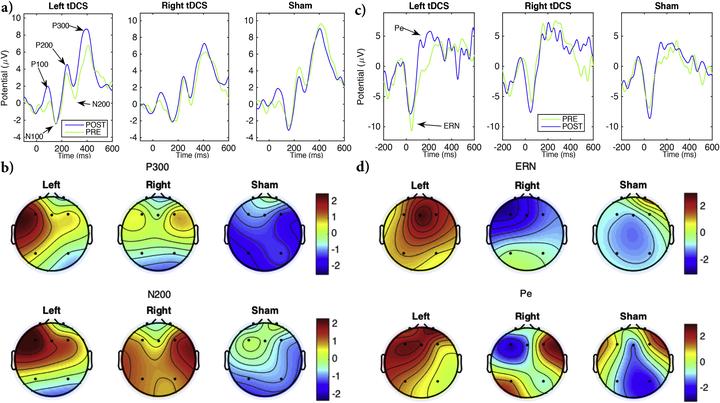tDCS to the left DLPFC modulates cognitive and physiological correlates of executive function in a state-dependent manner

Abstract
Background The use of transcranial Direct Current Stimulation (tDCS) to study anatomical and physiological dynamics and circuits supporting cognition and executive functions in particular has dramatically increased in recent years. However, its mechanisms of action remain only partially understood.
Objective In this study we assess the cognitive and physiological effects of anodal tDCS to the DLPFC on executive function in order to understand (1) the role of DLPFC laterality, (2) the physiological dynamics sustaining the modulation of executive function by tDCS, and (3) the impact of state-dependent dynamics.
Methods In a randomized, placebo-controlled, cross-over study, we applied anodal tDCS targeting the left vs. right DLPFC vs. sham in 20 healthy individuals (10 males, 10 females). Immediately before and after tDCS, subjects performed the Flanker Task while we measured behavioral (reaction time and accuracy) and neurophysiological (ERP) responses. Specifically, the amplitude of N200, P300, ERN and Pe is compared before and after stimulation.
Results Anodal tDCS to the left DLPFC lead to a significant improvement in reaction time, an increase in P300 amplitude and a decrease in N200 amplitude in a state-dependent manner: baseline ERP amplitudes conditioned the effects of tDCS.
Conclusion Given the role of these ERPs in conflict-related tasks, we speculate that tDCS is modulating the subconstructs of selective attention, conflict monitoring and response inhibition. These findings contribute to a further understanding of the role of left DLPFC in the modulation of executive function, and shed light into the mechanisms of action and the state dependent nature of tDCS.
Highlights
- Anodal tDCS to the left DLPFC leads to faster reaction times in the Flanker task.
- Cognitive improvement is correlated with changes in N200 and P300 amplitudes.
- Baseline physiology predicts cognitive and physiological effects of tDCS.
- N200 and P300 amplitudes correlate with reaction time on a trial by trial basis.